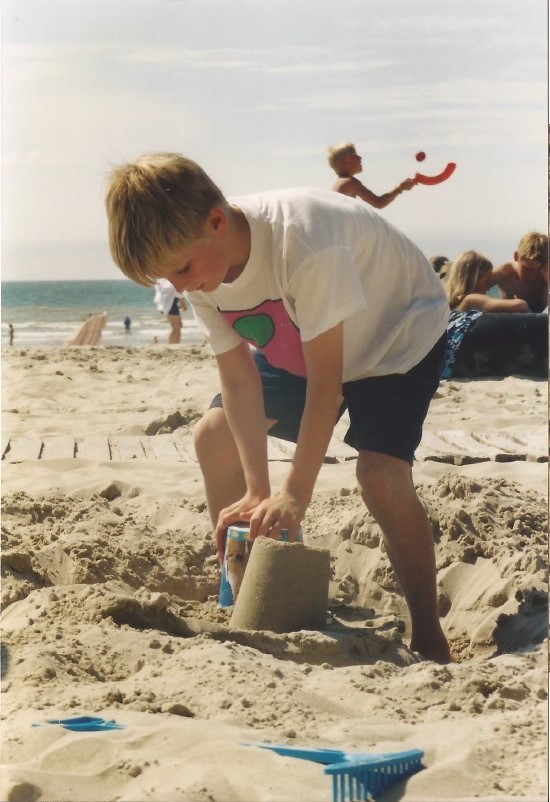Steak tartare at Café Les Sports, Le Touquet.
Throughout my childhood and adolescence, my family would spend a week or so each summer or Easter in a town called Le Touquet on the north coast of France. My mother, uncles and grandparents co-owned an apartment there. It was very much a home away from home, in part because of the familiarity and comfort of our rituals.
It was always the same. Someone would have to cycle to the bakery at an ungodly hour to get fresh pain au chocolat for breakfast. We would try (and fail) to keep the baguettes sand-free at the beach and have pâté en croûte and cornichon on the terrace in the evenings. We would go for apéritifs at the Westminster Hotel and play cards after dinner. There were endless games of sardines (a sort of reverse hide-and-seek, where one person hides and the rest have to find them) and tide-fights and lemon sorbet.
Dining was always a big part of these holidays, and by using our apparently charming ‘franglais’ we established ourselves as yearly regulars at a number of local spots. To this day, my grandfather remains friends with many of the local restaurant owners and chefs.
Our favorite spot was Cafe Les Sports, a red-lit restaurant and bar just a few blocks from the beach. Whenever we went, at least half of our party would order the same meal: a starter of moules marinières avec frites, followed by steak tartare, with a crêpe Suzette to finish. Though all delicious, the main event was unequivocally the steak tartare, which was made on a counter right in the middle of the dining area by a surly, large-bellied, mustached Frenchman.
Steak tartare is one of those dishes with no standardized recipe – each person has their own unique combination of ingredients and levels of seasoning. My father sometimes makes the dish at home, and it’s not bad. But it has nothing on the steak tartare made by monsieur mustache at Café Les Sports. The minced steak is fresh in flavor and texture, and along with capers, onions, and egg yolk, he adds a dash of ketchup. Every mouthful feels light; the flavors, perfectly balanced. The steak tartare became an important part of the family holiday, a ceremony as significant as Christmas dinner or New Year’s Day cold cuts, a yearly event that we would all vocally anticipate.
This all changed in 2008, when my uncle George was diagnosed with a malignant brain tumor. I was 17 at the time. Over the next 18 months he underwent various treatments, but the tumor was inoperable and the prognosis was unalterable. It was decided that the apartment should be sold to help pay for treatment that would make his remaining time as comfortable as possible.
So in 2009, a small group of us went to clear out the flat. When we arrived, the place already seemed different, more like a showroom. It felt like no one had lived there in years. We took down pictures that I’d never really looked at before. They were etched into my memory, but only as elements of our Le Touquet visits; taken out of that context, they seemed abstract, almost alien. Eventually the whole apartment began to feel foreign. It was the same with the furniture – had it always been this color? Was the fridge always this small? Had this rug always been in the middle of the living room? Of course, the apartment hadn’t changed. Our final adieu to the place was a tearful affair, but then it wasn’t really the apartment we were saying goodbye to.
We rounded off the trip with dinner at Les Sports. I ordered the steak tartare, as did my father and a few of the others. And there was monsieur mustache, standing behind his counter as always. The steak tartare was still just as delicious, still somehow rich, velvety, and yet light.
My uncle passed away in 2010. Le Touquet is no longer home, but we still take trips out there – in fact, we spent a week out there last summer. We were 15 family members and friends, and we rented out a small house. We cycled around town, and tried to keep our sandwiches sand-free at the beach, and ate pâté en croute and cornichon. And of course we went to Café Les Sports and had steak tartare.
These days, our trips feel more like we’re recalling memories, revisiting old haunts just to see how much they’ve changed. The town is slowly modernizing. The beach has transformed and some of the old restaurant-owners are gone. The town’s residents are no longer recognizable. But one thing that hasn’t changed is Café Les Sports’ steak tartare – a piece of my childhood, a family sacrament, preserved by a surly, large-bellied, mustached Frenchman.
Tags: Childhood, France, Holiday, Le Touquet, Les Sports, Steak Tartare

Your Comments